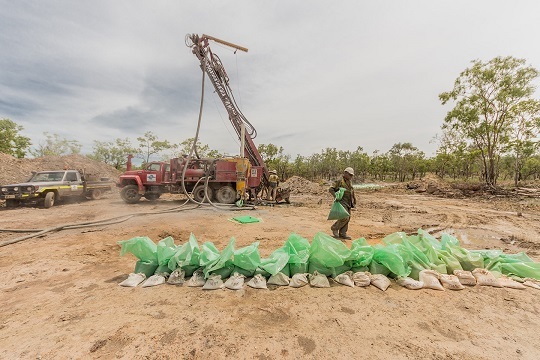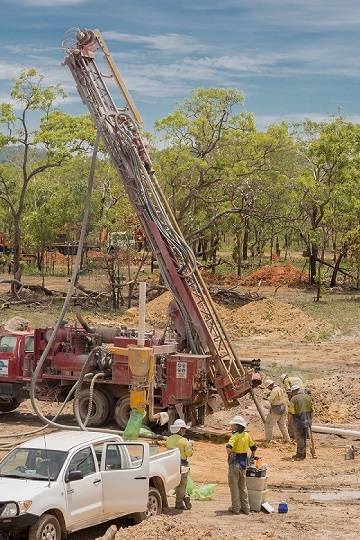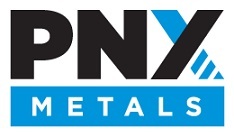PNX hit the ground running at what it called its Hayes Creek project back in 2014 and now only a few years later is nearing delivery of a prefeasibility study on a start-up zinc-gold-silver development that would not only demonstrate its producer bona fides, but also position it to systematically explore an area it has learned a lot about in the past three years.
“At the time of acquisition in 2014, PNX identified an opportunity to re-assess the deposits to focus on the base metals component, in particular the zinc, as the deposits had previously been modelled primarily for their gold and silver mineralisation,” PNX CEO and managing director James Fox said of the Iron Blow and Mt Bonnie deposits, about 3km apart, at Hayes Creek.
“With a better understanding of the ore genesis and controls over the mineralisation PNX resource drilling has identified several near-surface extensions to mineralisation that were previously unknown.
“The Iron Blow and Mt Bonnie VMS [volcanogenic massive sulphide] deposits are unusual for the region in that they contain significant concentrations of silver and zinc in addition to gold, and are the only known deposits of this type. As VMS deposits typically occur in clusters PNX is now in a very good position to use the knowledge it has developed over the last few years to target new mineralisation of a similar style in the region.

“With a significant increase in the zinc price over the last 12 months and strengthening of gold and silver prices, any additional mineable resources identified in the region that can be incorporated into the future development of the Hayes Creek project will only add to what are already attractive project economics.”
PNX is working now to establish an economic zinc-gold-silver operation at Hayes Creek by 2019 after its early-2016 scoping study showed the project’s 178,000 tonnes of zinc, 257,000oz of gold and 16.3Moz silver resource base (plus lead and copper) could potentially deliver robust returns from what was then seen to be a shortlived surface mine followed by longer-term underground development.
More drilling, and metallurgical testwork, has since improved the picture on several fronts.
Fox said the PFS, due for completion in June, would improve the accuracy of scoping numbers, and reduce the risk factors. PNX had outlined a A$65 million project with the potential to generate net cash of $244 million over a plus-seven-year mine life. That was based on start-up, openpit extraction at Mt Bonnie, followed by underground production from Iron Blow.
“The PFS will aim to deliver a more robust proposition by looking at incremental improvements across the project to maximise returns,” he said.
More clarity has come from results of the 7,500m diamond and RC drilling programme at Iron Blow and Mt Bonnie, completed in January, which confirmed the potential for low-cost, near-surface resource extraction at Iron Blow. The option is expected to be crystallised in a resource update due to be posted next month, with that report also likely to show most of the Iron Blow resource has moved into indicated status.
PNX recently revised the Mt Bonnie resource up to 1.55 million tonnes, 90% of it indicated, containing 58,000t of zinc, 6.3Moz silver, 66,800oz gold, 12,300t lead and 3,400t copper, at average zinc and gold equivalent grades of 9.5% and 7.8g/t, respectively. The deposit remains open, near-surface to the south, where PNX sees potential for more oxide mineralisation and also two potential ‘feeder’ zones at the base of the deposit.
On a district scale, too, PNX is getting good encouragement for its exploration thesis at Moline, 65km east of Hayes Creek, where recent drilling intersected zinc-gold-silver-lead rich sulphides, and Tumbling Dice, about 1km south of the old Moline opencut, where drilling intersected a broad zone of gold and zinc mineralisation at the southern end of a known gold trend.
“The results have highlighted the potential for the Moline area to host mineralisation similar to Hayes Creek,” Fox said, “and could represent the distal expression of a larger base metals system.”

Follow-up drilling is planned for later this year.
Fox said there had been very little deeper exploration work generally in an area only 170km south-east of NT capital, Darwin, with quality mining infrastructure and its long history of production. But the results of new drilling, such as the assays from nine infill and extensional holes only recently completed at Iron Blow, only underlined the latent prospectivity of the whole land package.
Results included 15.6m grading 16.8% zinc-equivalent (12.25% zinc, 2.28g/t gold, 214g/t silver, plus lead and copper credits) from 64.2m; 12m of 13.6% Zn-Eq from 40m; and 19m of 9.7% Zn-Eq from 67m, across the east-west span of the deposit.
“This near-surface mineralisation intersected introduces the potential for an initial openpit in addition to the previously considered underground mine,” Fox said.

“The scoping study envisaged no openpit mining at Iron Blow so this is very much all upside. This could provide lower risk, earlier cash flows and lower unit costs.
“Once the final assays have been received and the resource upgrade completed we’ll be in a position to commence the mining optimisation studies at Iron Blow. These will assess the most efficient way of mining ore from Iron Blow and develop a mining schedule in conjunction with Mt Bonnie.”
Meanwhile, the company would aim to “continue to delineate resources and test exploration targets with VMS and gold potential in close proximity to Iron Blow and Mt Bonnie to increase the resource base”.
“Target stratigraphy can be traced on the surface for at least 10km with numerous additional areas identified within the broader project area to be followed up.
“Very little drilling below the many oxide gold deposits that exist in the area has occurred and yet the potential exists for significant sulphide mineralised systems.
“There has been little justification for the exploration of primary mineralisation whether it be base or precious metals sulphides in the area as there are no existing options for processing this type of ore. PNX’s development of a process plant to treat sulphides via flotation to generate concentrates would open up the area.”
The company has scoped out infrastructure and site selection locations and started PFS-level process plant front end engineering design. A notice of intent is being finalised for submission shortly which includes a number of “innovative measures to manage waste rock and tails residue”, according to Fox.
Metallurgical work to date has supported PNX’s plan for a process flowsheet able to separately yield a zinc concentrate, and gold-silver concentrate.
“Overall recoveries of the payables are excellent and recent optimisation has further improved distribution and separation of the metals within the concentrates,” Fox said.
Concentrate grades had also increased through the rejection of iron and other deleterious elements, while arsenic levels are within specifications for a saleable zinc concentrate.
“PNX is finalising a test work program designed to establish the metallurgical inputs for resource modelling and PFS flow-sheet design," Fox said. "The focus has been on recovering as much of the key payable metals as possible, being zinc, gold and silver via simple flow-sheet design.
“This has been developed to generate two saleable product streams, a clean zinc concentrate and a gold/silver concentrate.”
The company is also continuing to fine tune Hayes Creek’s cost inputs. The current capex number is roughly in line with similar-scale projects elsewhere but Fox said cost and construction-time reduction options were being examined.
“For example, utilising mobile jaw and cone crushers and a semi-permanent run-of-mine bin could reduce timelines and cost,” he said.
“For the estimated mine life feed rate we may not need to go to the cost and effort of permanent installation.”
PNX Metals – at a glance
HEAD OFFICE: Level 1, 135 Fullarton Road, Rose Park, South Australia, 5067, Australia Telephone: +61 8 8364 3188 Email: info@pnxmetals.com.au Web: www.pnxmetals.com.au DIRECTORS: Graham Ascough, James Fox, Paul Dowd, David Hillier, Peter Watson QUOTED SHARES ON ISSUE: 736.1 million MARKET CAP (at March 21, 2017): A$17 million MAJOR SHAREHOLDERS: JP Morgan Nominees (8.7%), Potezna Gromadka (8%), Marilei International (7.6%), Sochrastem (6.8%), directors/management (3.4%)
|


























